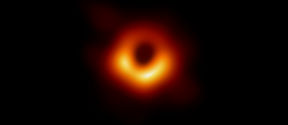Astronomers capture first image of a black hole
Aalto University contributed to paradigm-shifting observations of the gargantuan black hole at the heart of distant galaxy Messier 87

Over the last two years Academy Fellow Tuomas Savolainen has analysed a massive amount of data of a black hole located in outer space. He is one of the over 200 researchers part of the international Event Horizon Telescope collaboration, the group responsible for the very first image of a black hole, released 10 April 2019.
The breakthrough wasn’t guaranteed. While some of the Event Horizon studies had delivered promising results, as the group gathered at Harvard in the hot summer of 2018, Savolainen wondered whether they would be able to make astronomical history.
Suddenly the room filled with the field’s top minds broke into applause. The data projected on screens clearly showed that four independent groups, with different methods, had gotten the same results. While huge amounts of work would still be required for a final, publishable finding, those in the room knew that the ambitious goal was finally in reach—they had an image of a black hole.
‘Researchers had come from around the world to sit down together for an intensive week of work. In an instant people went from deep concentration to excitement and smiles. When we saw the images, there was a feeling of celebration,’ Savolainen recalls of the moment of unveiling.
The first image of a black hole is now out. Or to be more accurate, the released image shows the shadow or silhouette of the black hole against the light emitted by the gas falling into it—since black holes themselves do not radiate light, as their name suggests.
The weight and distance of black holes are difficult to understand; the black hole captured is equivalent in weight to approximately 6 billion suns and is located 55 million light years away. So why is it so important to study?
‘The gravitational force of black holes gives us the chance to test Einstein’s General Theory of Relativity—still one of the pillars of modern physics—in conditions that we simply cannot find elsewhere,’ Savolainen explains.
The image also provides the most persuasive evidence to date that supermassive black holes actually exist. In fact, it confirms decades of theorisation; supermassive black holes have been long thought to exist at the centre of active galaxies, and now there is visual documentation.
With the image researchers can, for the first time, directly study the boundary from which the black hole sucks everything in, including light. Called the event horizon, the behaviour of light around this boundary will now be a major topic of study.
‘The event horizon is no longer a just a mathematical concept—we’ve moved to the experimental stage. We can replicate experiments and improve their accuracy by adding telescopes to the network, as well as by using shorter wavelengths, which make more exact tests of general relativity possible. The Event Horizon Telescope has essentially opened a new way of studying gravity in the most extreme conditions,’ says Savolainen.

Aalto University contributed to paradigm-shifting observations of the gargantuan black hole at the heart of distant galaxy Messier 87

Six press conferences will be held simultaneously around the globe.

They’re giant, destructive vacuums with the power to rip stars apart, yet evidence points to the helpful role black holes also play as galaxies form.




